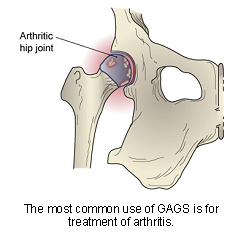Glycosaminoglycans (GAGS)
What are glycosaminoglycans?
Glycosaminoglycans (GAGs) are complex molecules composed of proteins and sugars, and are found in a variety of bodily tissues, including the blood plasma, joints, and the mucosal (mucous membrane) lining of a variety of organs, including the gastrointestinal tract and the bladder. Various compounds exist. Heparan and dermatan coat the urinary tract of cats while glucosamine and chondroitin constitute the major GAGs in the joint. They are among the most prescribed supplements in all of veterinary medicine. (also see our separate articles on glucosamine and chondroitin in this series.)
Why recommend administration of GAGs to my pet?
Pets with arthritis are often treated with GAGs. GAGs function similar to aspirin and other non-steroidal anti-inflammatory drugs (NSAIDs) by decreasing the production of harmful pro-inflammatory compounds including prostaglandins that may degrade the cartilage matrix. This results in reduced pain and inflammation, and permits cartilage synthesis to occur. GAGs can also serve as the structural building blocks of this new joint cartilage, giving them a double benefit in the management of degenerative joint disease and osteoarthritis. Finally, GAGs appear to increase the synthesis of proteoglycans, hyaluronic acid (which acts as a joint lubricant,) and collagen, all of which are needed for proper joint structure and function.
"...may take 4 to 8 weeks to produce improvement..."
GAGs are not effective in all animals, however, and may take 4 to 8 weeks to produce improvement in animals that do respond. While most studies of the benefits of GAGs utilize injectable preparations, oral supplements appear to be largely well absorbed.
 Other potential indications for glucosamine include the treatment of intervertebral disk disease, recurrent cystitis (bladder inflammation), and severe inflammatory bowel disease. Disk disease is associated with abnormal compressive forces on disks, necessitating their remodelling and repair. Glucosamine has been suggested as a potential source of the proteoglycan molecules needed during these processes. Cats have been shown to experience a reduction in the glycosaminoglycan layer coating the urinary tract with age. Reduced levels of dermatan and heparan are also a feature of cats with feline lower urinary tract disease, especially interstitial cystitis, suggesting that GAG supplementation may be of benefit in reducing inflammation and recurrence. GAGs may also provide protection for the gastrointestinal mucosa in inflammatory bowel disease.
Other potential indications for glucosamine include the treatment of intervertebral disk disease, recurrent cystitis (bladder inflammation), and severe inflammatory bowel disease. Disk disease is associated with abnormal compressive forces on disks, necessitating their remodelling and repair. Glucosamine has been suggested as a potential source of the proteoglycan molecules needed during these processes. Cats have been shown to experience a reduction in the glycosaminoglycan layer coating the urinary tract with age. Reduced levels of dermatan and heparan are also a feature of cats with feline lower urinary tract disease, especially interstitial cystitis, suggesting that GAG supplementation may be of benefit in reducing inflammation and recurrence. GAGs may also provide protection for the gastrointestinal mucosa in inflammatory bowel disease.
How much experience is there with the use of glycosaminoglycans in pets?
GAGs have been used for many years as a treatment for pets with arthritis. These products have a long track record of clinical safety.
What species of animals are being treated regularly with GAGs?
Dogs, cats, and horses are the main species treated with these supplements.
How much research has been conducted on this supplement?
GAGs have been shown to be effective in the management of degenerative and inflammatory joint disease. These research results are echoed by clinical experience, although not all animals will appear to respond.
"Variations in product quality may account for some of the inconsistencies in clinical efficacy."
Variations in product quality may account for some of the inconsistencies in clinical efficacy. While glucosamine and chondroitin are available in oral forms, injectable forms are also available for intramuscular or intra-articular (into the joint) injection.
How safe are GAGs?
They are very safe, especially when compared to the side effects of treatment with NSAIDs. The only conceivable downside to their use in most cases is that they may not work. Side effects with injectable GAGs are extremely rare but are reported to include a dose-dependent inhibition of blood clotting. It is recommended that your veterinarian monitors your pet's blood coagulation parameters on a regular basis. Initially, there were concerns about supplementation with GAGs in diabetic animals, since they are made from glucose or blood sugar. Current research shows, however, that glucosamine is safe to use in these animals, although it is still prudent to monitor blood sugar levels in diabetic pets (especially if higher doses of glucosamine are used) as alterations in insulin levels might rarely be needed.
Where do I obtain glycosaminoglycans and do I need a prescription?
Consumers need to be aware that these supplements are not highly regulated, and products intended for oral consumption may vary widely in content and quality of glycosaminoglycans, depending on the manufacturer. Many of these products are available over the counter without a prescription. Injectable products are administered by veterinarians, sometimes with the patient under sedation, and require a prescription. Your veterinarian will be able to recommend preferred brands of supplements that are available in your area.







